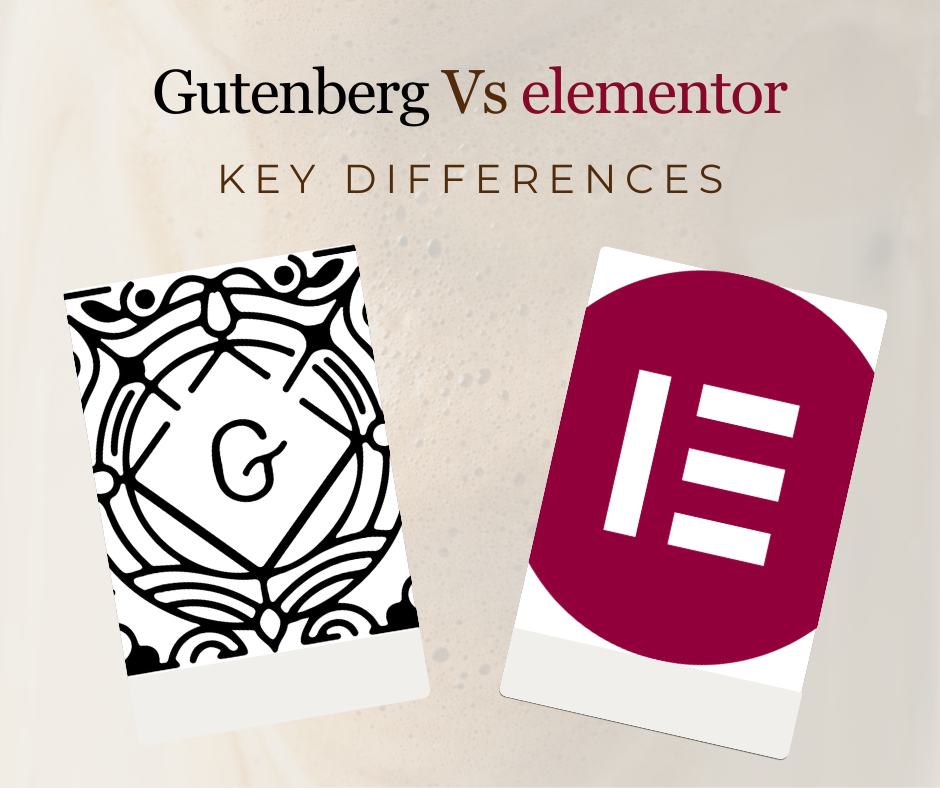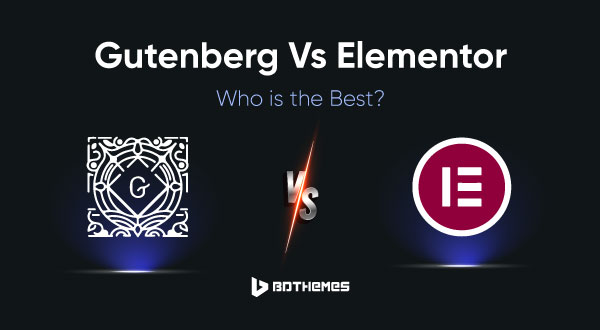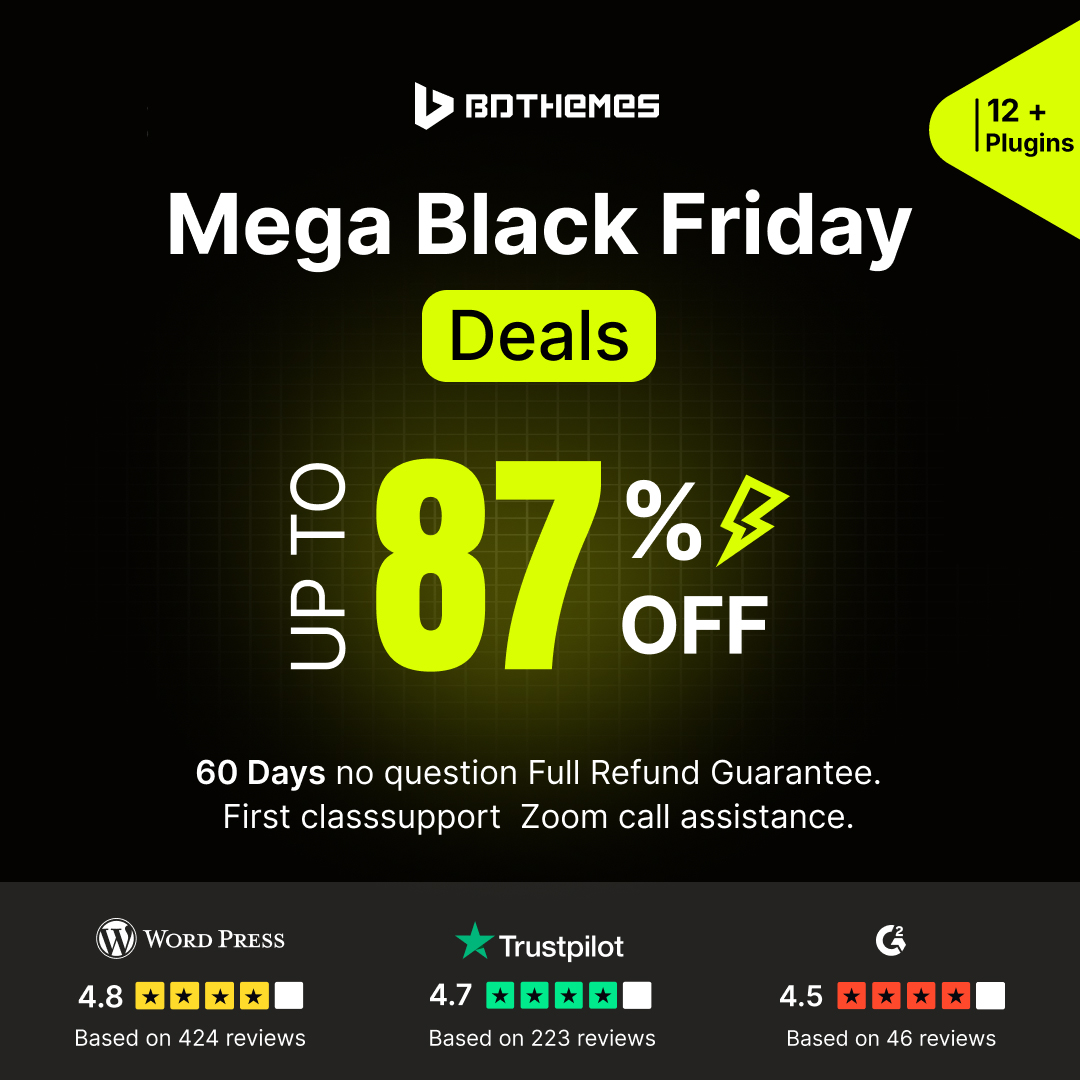Are you looking for a rapid comparison between Gutenberg vs Elementor?
Don’t worry! You are not the only one looking to choose the right page builder. This comparison is a common question among WordPress users. Both page builders have their benefits, making it hard to pick one for your website.
Elementor is an interactive page builder with better customization and more built-in templates. However, Gutenberg is a WordPress default block editor with limited customizations but loads fast. So what’s new in 2023? You will know everything from this post.
Before delving straight into the comparison, let’s start with an overview of Elementor and Gutenberg. Then, we’ll discuss key features and compare each other in detail.
What is Elementor in WordPress?
Elementor is a visual builder plugin in WordPress that lets you craft pages by dragging and dropping elements.
It is mostly used to make websites with advanced layouts or complicated styles without knowing how to code.
Most importantly, you can use Elementor Pro to create a full WordPress theme. It was first introduced in 2016 and has become very popular among WordPress users.
Elementor has a lot of features, such as visual layout, customization options, pre-built themes, and the ability to change the whole site. It is made with accessibility in mind and has tools and settings for a better user experience.
It has received multiple upgrades and enhancements since its debut. Although Elementor has a lot of changes in changelogs. Here is a glimpse of some upgrades from its first to final version:
| Version | Release year | Features and Improvements |
| 1.0 | 2016 | Adds visual interface with, a wide range of customization options |
| 2.0 | 2018 | Added new design system, new color picker, new font system, new theme builder |
| 3.0 | 2020 | Performance improvements, new landing page workflow, and new “Experiments” feature. |
| 3.1 | 2021 | Performance improvements, new landing page workflow, new “Experiments” feature. |
| 3.6 | 2022 | Introduced Flexbox container |
| 3.11.0 | 2023 | Introduced a new taxonomy Filter widget, revamped Accordion widget |
| 3.12.0 | 2023 | Introduced Elementor AI and CSS grid layout in the container |
| 3.13 | 2023 | Introduced new taxonomy Filter widget, revamped Accordion widget |
| 3.14.1 | 2023 | Introduced carousel widgets, bug fixes, and performance improvements. |
| 3.15 (beta) | 2023 | Introduced a new taxonomy Filter widget, revamped Accordion widget |
| 3.16 | 2023 | last update with some fixes and a tweak |
| 3.16.3 | 2023 | last update with some fixes and a tweak |
| 3.18.2 | 2024 | Performance improvements and accessibility enhancements |
| 3.19.0 | 2024 | Introduced loop carousel, Advanced Rules with Date and Time Range, and Improved accessibility across various widgets |
| 3.19.2 | 2024 | Fix integration script for AI |
These are some of the most significant updates and improvements. If you want to know more about its changes, check this changelog.
From the version table, you have learned that Elementor introduced AI in its functionality.
What is Elementor AI?
Elementor AI is the latest feature integrated into the Elementor page builder, using artificial intelligence to enhance website creation. It offers the following features:
- Generate Text: Quickly create website content with an AI writing assistant.
- Modify Text Tone: Adjust and fine-tune text to fit your needs.
- Translate: Easily translate website content into different languages.
- Fix Spelling and Grammar: Correct spelling and grammar errors in your content.
- Create Original Images: Generate original images for your website.
- Modify Images with Generative Fill: Customize images using generative fill.
- Generate Custom Code: Create custom code, including HTML, Custom Code, and Custom CSS.
- Relevant Suggestions: Receive context-based suggestions for using AI with different assets.
Elementor AI is available to all Elementor users from version 3.13 and above. While many features are accessible to all users, some advanced capabilities, such as custom code suggestions and HTML/CSS selector results, are only available to Elementor Pro users.
What is Gutenberg in WordPress?
WordPress used to have a classic editor called Tiny MCE, primarily used for blogging with static pages. By the end of 2018, WordPress launched Gutenberg, a block-based editor for building websites using drag-and-drop blocks.
Back in the day, people would either code or use page builders to customize their web pages. While page builders are still used to creating interactive websites, some have compatibility issues with certain themes and plugins. In these cases, Gutenberg can be a suitable option.
Gutenberg is a game-changer for content creation, offering block-based editing to quickly create blog posts and landing pages. It allows full site editing within the editor and includes all necessary elements for web page creation. Gutenberg also has pre-installed block-based widgets and is compatible with third-party addons and plugins.
| WordPress Version | Key Changes |
| 5.0 | The debut of Gutenberg in WordPress as an editor |
| 5.1 | Added support for block patterns |
| 5.2 | Added support for block spacing |
| 5.3 | Added support for keyboard shortcuts |
| 5.4 | Added support for accessibility features |
| 5.5 | Added support for theming |
| 5.6 | Added the Block Editor API |
| 5.7 | Added support for block-based widgets |
| 5.8 | Added support for full site editing |
| 5.9 | Added support for block-based menus |
| 6.0 | Added new Webfonts API and design tools |
| 6.2 | Added new stable Site Editor, scaled block settings, color-coded labels for Templates, new Style Book, Custom CSS support for specific blocks |
| 6.3.1 | Bug fixes for block editor |
| 6.4 | Will introduce image light box block and auto insert block feature |
| 6.4.3 | Site Editor Enhancements, Font Library updates, and improved Block Hooks API |
Since it was first introduced in WordPress 5.0, the Gutenberg block editor has evolved in many ways.
Well, you can see how the Gutenberg block editor has changed a lot over the past few years. It has become a powerful tool that makes it easier and more flexible for users to edit and customize content. We’re looking forward to seeing what new features and functions the block editor gets in the future.
Now that you have acknowledged the overview of Elementor and Gutenberg. Let’s start by comparing its key features and differences in detail.
You already know some features of both page builders from the overview. Find out more in detail about the key features in the next section.
Key Features of Elementor
- You can create an enticing webpage without writing any code.
- Simplify the process of developing a highly functional website by using a simple drag-and-drop interface.
- Fully responsive
- Support live editing
- Access a wide range of pre-designed templates that are ready to use.
- Efficiently add multiple columns and intricate layouts to your webpage.
- Utilize over 90+ professional widgets, similar to Gutenberg blocks, to enhance your website.
- Have control over margins, padding, spacing, and other styling options.
- Expand your options for designing sections and widgets with additional styles.
- Design unique headers, footers, and body sections for your website.
- Integrate seamlessly with e-commerce plugins like WooCommerce.
Elementor also has pro versions, which have more advanced features.
- Elementor Pro offers powerful tools like Animated Headlines, Forms, Slides, and other important functionalities.
- The pro feature has a more advanced collection of pre-made templates and widgets.
- Elementor Pro offers a theme builder that empowers users to create custom headers, footers, and other theme components according to your specific requirements.
- Elementor is the first-page builder with AI integration. It allows users to generate and enhance text and custom code (HTML, Custom Code, and Custom CSS). This integration saves time and effort by automating website creation tasks.
These unique features make Elementor very popular in the WordPress community. Loved by the 5 million plus users active installation in the WordPress plugin directory. Many third-party developers have developed exclusive addons for Elementor to enhance its functionality. One of them is Element Pack Pro, which offers a complete package to build a professional website. If you want to know about the Element Pack, you can check Element Pack Pro vs Element Pack Lite.
Key Features of Gutenberg
- The block editor UI is super easy to use, making it perfect for beginners and non-tech folks.
- It’s designed in a way that lets you create content by simply adding and arranging blocks.
- It has several blocks like texts, images, tables, buttons, etc
- Gutenberg editor supports the drag and drop function to move and rearrange content.
- The block editor is very customizable, you can adjust its appearance and feel to fit your needs.
- The block editor is flexible, you can create custom blocks and block patterns and reuse them on other pages.
- You can track your work status and revisions on Gutenberg from the side panel.
- You can create dynamic pages using the block editor by controlling the layout and design of the content.
- You can use a third-party block plugin to enhance the page-building experience.
- Gutenberg editor allows you to create responsive content and make pages load faster.
Gutenberg has 77.5+ million active installations on WordPress, with over 279 million posts written in the editor. It is widely used by millions of sites. It is free to use.
Now that we know in detail about Elementor and Gutenberg’s features. Let’s dive into the main moto “ Elementor vs. Gutenberg”
Elementor vs Gutenberg: Key Differences

Want to know how Gutenberg and Elementor compare? Let’s check out their key features side by side!
| Features to Differ | Elementor | Gutenberg |
| Type | Page builder plugin | Block editor |
| Drag & Drop Features | Yes | Yes |
| Live Editing | Yes | Yes |
| Backend vs Frontend Editing | Frontend | Backend |
| Advanced Formatting | Yes | limited |
| Page Speed | Slower than Gutenberg | Faster than Elementor |
| Responsiveness | yes | yes |
| Ease of Use | very user friendly | good for SEO |
| Support | Excellent Support system | Good support and documentation |
| SEO | Backend vs. Frontend Editing | good for SEO |
| Features to Differ | Large library of pre-built blocks and widgets | Limited pre-built blocks and widgets |
| Template Library | Large library of pre-built templates | Limited pre-built templates |
| Compatibility | Compatible with WordPress themes and plugins that are Elementor-supported | Compatible with all WordPress themes and plugins |
Well, from the key difference table, you can easily get a sneak peek. But why there are differences, let’s delve into it more.
Gutenberg and Elementor Characteristic Difference
Type
Both Gutenberg and Elementor are used as page builders in WordPress.
Gutenberg is the default block editor for WordPress. It’s included in every WordPress installation since version 5.0.
On the other hand, Elementor is a page builder plugin for WordPress that helps you build web pages. You need to install it separately as it’s not part of the WordPress core.
Purpose
Gutenberg is a content editor that helps users create and edit posts and pages. To simplify customization, it breaks content into blocks like paragraphs, headings, and images.
However, you can use Elementor to create elegant designs and form custom layouts for your web pages. It lets you visually build pages with the help of advanced design elements.
Functionality
Gutenberg and Elementor have many features that make it useful for WordPress theme design and customization.
Gutenberg is primarily a back-end editor. But Elementor has both backend and front-end editing features.
At Gutenberg, you can preview your changes by clicking the button. But on Elementor, you can see changes in real time while editing live.
Gutenberg enables you to add, rearrange, and customize blocks. But Elementor lets you drag and drop widgets and templates to create complex page designs.
You will find a simple editing experience in Gutenberg. At the same time, Elementor offers animation and advanced styling options.
Customization
While Gutenberg has some design options, it’s less advanced than dedicated page builders like Elementor.
You can add custom CSS to both Gutenberg and Elementor.
Elementor lets you create custom headers, footers, and archive pages. Now you can also create custom headers, footers, and pages through Gutenberg in WordPress Full site editing.
Gutenberg is compatible with all themes and plugins. However, Elementor sometimes has problems with unsupported themes and plugins, which you can solve with additional coding and developer support.
Page Loading Speed
Page loading speed is one of the important factors for a website’s user experience. Every second counts, so a slightly slower page load may lose the website audience.
Gutenberg is super fast as it is built into the core system of WordPress. But Elementor is slower than Gutenberg as it is a third-party plugin.
Gutenberg is a very lightweight text editor and doesn’t load any files or code unnecessarily. But Elementor has many external scripts, parallax effects, and dynamic elements that increase loading time.
A cool feature of Gutenberg is its Server-side rendering, which speeds up page loading by doing most of the work on the server. However, Elementor has dynamic asset loading and page compression features to load pages faster.
Elementor also gives additional tips for their users to optimize their slower websites. Such as:
- Compress your image and video sizes
- Use a caching plugin
- Avoid unnecessary use of plugins
- Use a lighter theme
- Optimize your website code and database
- Use a hosting plan with a lightspeed server
- Apply CDN ( Content Delivery Network)
SEO Friendly
SEO is very important for a WordPress website and both Gutenberg and Elementor are completely SEO friendly.
You can write SEO-friendly content on both Elementor and Gutenberg. On Elementor you can create content-rich pages with granular control to enhance SEO further.
Gutenberg has a block for structured markups that increases the chances of rich snippets in search results. Similarly, using Elementor, you can add structured data to your content in the form of schema.
You can optimize image indexing through alt text in both Gutenberg and Elementor.
Both page builder integrates seamlessly with popular SEO plugins like Yoast SEO and Rank Math, simplifying content optimization for search engines.
Responsiveness
A responsive design helps you expand your audience, which increases the chances of increased conversion from visitor to potential customer. Thankfully Gutenberg and Elementor are responsive.
Both Gutenberg and Elementor can adapt text and graphics to any device’s screen size for a user-friendly experience.
Elementor allows you to adjust Individual components, columns, and sections with the help of responsive controls. On Gutenberg you can preview mobile views while editing, and with a well-coded, responsive theme for a smooth mobile browsing experience.
Ease of Usage
Both Gutenberg and Elementor are easy to use and don’t require you to know how to code.
All you need is to click the plus sign in the block editor to add a block and start customizing the block by changing its size, color, and other settings.
Similarly, you drag widgets from the Elementor panel and drop them onto the page. You can then customize the widget by changing its settings.
Support
If you are stuck, you can get help from both Gutenberg and Elementor’s support.
If you are using Gutenberg, get your support from the WordPress community. Otherwise, take help from WordPress forums, official documentation, and many online tutorials and articles related to Gutenberg.
Elementor has the best support for its users. You can get help from Elementor forums, documentation, and blogs or open a ticket from the official website. On the other hand, if you are using Elementor Pro you can get additional support.
So, which one should you choose? If you crave design freedom and customization, go for Elementor. But if you prefer a straightforward and hassle-free editing process, Gutenberg might be your best bet.
Gutenberg generally works well with most themes and plugins. Sometimes compatibility issues may arise when using other page builders alongside Gutenberg. Elementor is known for its solid compatibility across the WordPress community.
Don’t be confused, Overall, the choice between Elementor and Gutenberg depends on your needs and preferences. You can use both of them together.
Final Verdict: Gutenberg or Elementor
Finally, the Gutenberg vs Elementor comparison comes to an end. You have learned their features and differences in depth. Then you learn their key changes from their first version to the latest till now. Also, find out the newest features of Elementor called Elementor AI to enhance your customizing experience. Well, we hope soon Gutenberg also gets AI integration.
So which one is your take on 2023? you already know the answer. However, Gutenberg is a WordPress default block editor with limited blocks. Still, you can create dynamic websites using the help of third-party Gutenberg addons. On the other hand, Elementor is the top competitor of page builders with the most advanced features to deliver professional websites. You can’t underestimate one with the other. So Gutenberg vs Elementor battle is still unmatchable for each other. Both are awesome in their relevant fields.
Frequently Asked Questions
Do I Need Gutenberg If I Have Elementor?
No, you don’t need Gutenberg if you have Elementor. Elementor is a comprehensive page builder. If you still want to use Gutenberg for certain tasks, you can still use it alongside Elementor.
Do I need to install the Gutenberg plugin?
No, you don’t need to install an additional Gutenberg plugin. By default, Gutenberg is available on WordPress 5.0 or later version. It is now a built-in editor at WordPress.
Can I Switch From Elementor to Gutenberg?
Yes, you can switch from Elementor to Gutenberg. To do that you need to follow some manual work. If you have customized your website using Elementor features and widgets. Then you need to recreate some of the design elements using Gutenberg’s blocks and templates.
Do Professionals Use Elementor?
Yes, many professionals like designers, web developers, and digital marketers prefer Elementor and Elementor Pro. Elementor’s user-friendly interface and extensive customization options enable professionals to create high-quality websites more quickly and effortlessly.




